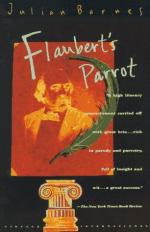|
This section contains 320 words (approx. 1 page at 400 words per page) |

|
Flaubert's Parrot Summary & Study Guide Description
Flaubert's Parrot Summary & Study Guide includes comprehensive information and analysis to help you understand the book. This study guide contains the following sections:
This detailed literature summary also contains Related Titles and a Free Quiz on Flaubert's Parrot by Julian Barnes.
Flaubert's Parrot tells the story of Geoffrey Braithwaite, an English doctor who is obsessed with Gustave Flaubert. Geoffrey states that he has three stories to tell: Flaubert's, his own, and his wife Ellen's. The novel is comprised partly of fiction and partly of literary criticism, as the book traces Geoffrey's search for the "facts" about Flaubert and his work. Geoffrey discovers that two museums containing items of Flaubert's claim to own the stuffed parrot that Flaubert once borrowed from the Museum of Natural History. Geoffrey discovers, in the last chapter, that the museums each choose one parrot from a collection of fifty, not knowing which parrot Flaubert had really borrowed.
In his search for Flaubert, Geoffrey discovers that the great author was involved with Juliet Herbert, although Ed Winterton destroyed the evidence of their affair. Geoffrey learns about the lives that Flaubert did not lead and the books that he did not write. Geoffrey dives into the criticisms of Flaubert and his faults. Through Flaubert's life and work, Geoffrey tries to make sense out of his own life.
Geoffrey's obsession with Flaubert covers his own hurt, confusion, and pain over his wife's death and his relationship with her. Ellen, his wife, had a number of affairs during their marriage and Geoffrey has conflicted feelings about her. Geoffrey tries to decide whether they were happy or unhappy in their marriage and if his wife really loved him or not. Geoffrey is also tormented by the fact that he shut off her life support, essentially killing her, even though he knows that there was no hope for her.
Told in a variety of different formats, the novel questions our assumptions about what history is and how we discover the facts of history. Virtually every chapter offers an alternate way of approaching the "facts" of history or a person, illustrating how our vision changes with the format and perspective.
Read more from the Study Guide
|
This section contains 320 words (approx. 1 page at 400 words per page) |

|



